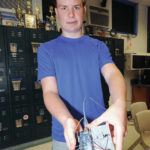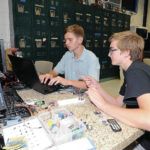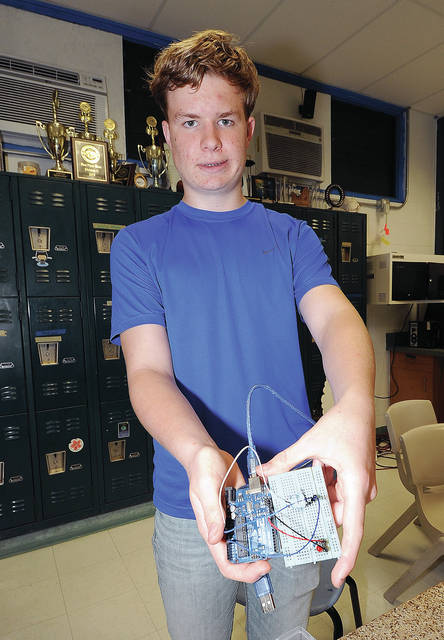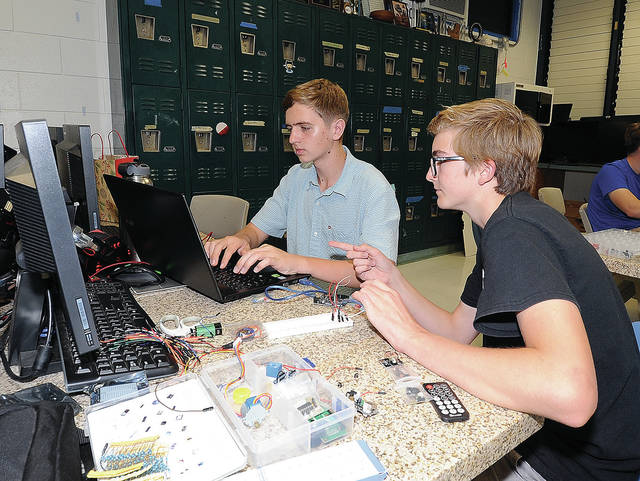KAILUA-KONA — As of Dec. 17, police have arrested 1,115 people on suspicion of driving under the influence, a more than 5 percent increase from the same time period last year, according to the Hawaii Police Department.
From Dec. 11-17, police arrested 24 people for suspected DUIs, five of whom were involved in a traffic crash.
With those statistics in mind, a team of bright minds at Kealakehe High School has taken up the cause of reducing drunk driving on the island.
Their vision to build a device that can evaluate blood-alcohol content in drivers already has been rewarded by becoming the first team in the state to receive a $10,000 grant through a national program from the Massachusetts Institute of Technology.
The team is one of 15 “InvenTeams,” an initiative through the Lemelson-MIT program dedicated to encouraging the next generation of inventors and problem-solvers. Kealakehe’s career and technical education coordinator, Justin Brown, was named a recipient of a Lemelson-MIT Excite Award earlier this year, identifying him as a finalist for the InvenTeam grant.
Students from Kealakehe’s STEM Academy and Robotics Program kicked off the InvenTeam application process in spring 2017. Through three “Shark Tank”-style rounds, more than 75 students pitched their ideas for final consideration.
Several of the student inventors said the program gave them a chance to look critically at problems facing their community as well as apply their own knowledge to solving those problems.
“I think everyone’s got a little bit of … ‘save the world’ in them,” said senior Julia Smith. “So, through InvenTeam, we’re able to take problems that we see in our community and actuate them in ways that couldn’t be done before, through understanding new technology and collaborating together.”
Sophomore Nathan Weir, who pitched the idea to tackle drunk driving, said the process gave students an opportunity to look to their community for problems and potential solutions.
“We were looking at what’s out there and why it’s not working and what we can do to fix it,” he said.
Freshman Alex Bell said that’s what makes their invention a really solid one; it’s solving a problem in their own community.
“Drunk driving is a big problem in Kona,” he said, referencing news reports of crashes involving someone intoxicated behind the wheel. “It’s really cool to actually be able to try and solve problems like that that will help your community.”
Weir said he had a couple of different ideas about how he wanted to curb drunk driving, but didn’t know how. Another student, he said, had also pitched an idea related more generally to drinking and how a person can know when he or she is intoxicated.
Combining those ideas led the team to take a novel approach to the issue — stop drunk driving before it even happens.
The students hit on the idea to use near-infrared spectroscopy, a technology already being put to use in the fields of medicine and astronomy.
Their invention, as envisioned by the team, takes a beam of light and shines it into a person’s hand. The light reflects off a person’s blood cells and back into the receiver, which measures the blood-alcohol content. The light will be reflected differently based on the concentration of any alcohol.
In a similar application, near-infrared spectroscopy already has shown promise as a noninvasive diabetes screening tool.
The exact form and placement of the device is still up in the air. Weir said they need to figure out the most compact and best way for the sensor to operate and to integrate the device into a car.
Bell added, for example, that it can’t be easily removable from a car once installed.
Of the $10,000, $3,000 is set aside for use by the mentor and teams have $7,000 for their own uses. Most of that, said Weir, is going to go toward prototyping, such as the sensors, other tech and how it will be integrated into the car.
The InvenTeams across the country will be able to have their inventions showcased at EurekaFest at MIT in June 2018 following a grant review in their community in February, according to a statement from the university.
And the grant, said the students, is just the beginning.
Bell said if they could get a patent on their invention, he’d like the opportunity to fine tune it to potentially publicly sell and distribute.
Weir, meanwhile, said he thinks the invention has the potential to evolve into a company.
“It could either turn into a company that we were selling by ourselves or we could do something, a partnership with Amazon, a partnership with insurance companies and just get it out there, partner with a manufacturer or just something like that,” he said. “I think we can definitely go farther with this.”
Email Cameron Miculka at cmiculka@westhawaiitoday.com.






